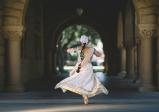In Indian Dance, however, the legs are usually bent, with the feet flat rather than lifted and pointed. Jumps are usually low (though light), and the dancer rarely covers much ground or performs intricate steps, the complexity of the footwork lying more in elaborate stamping rhythms
Dance in India comprises numerous styles of dances, generally classified as classical or folk. As with other aspects of Indian culture, different forms of ...
Classical dance of India has developed a type of dance-drama that is a form of total theater. The dancer acts out a story almost exclusively through gestures. Most of the classical dances of India enact stories from Hindu mythology.
The criteria for being considered as classical is the style's adherence to the guidelines laid down in Natyashastra, which explains the Indian art of acting. The Sangeet Natak Akademi currently confers classical status on eight Indian classical dance styles: Bharatanatyam (Tamil Nadu), Kathak (North, West and Central India), Kathakali (Kerala), Kuchipudi (Andhra), Odissi (Odisha), Manipuri (Manipur), Mohiniyattam (Kerala), and Sattriya, (Assam).








